engine Citroen C5 2017 (RD/TD) / 2.G Workshop Manual
[x] Cancel search | Manufacturer: CITROEN, Model Year: 2017, Model line: C5, Model: Citroen C5 2017 (RD/TD) / 2.GPages: 348, PDF Size: 10.72 MB
Page 114 of 348
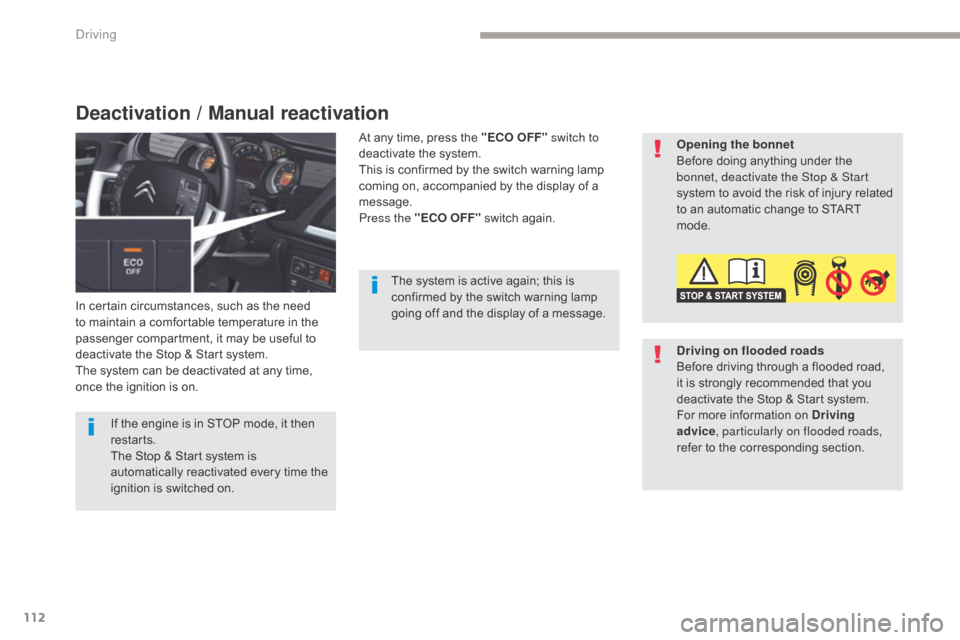
112
C5_en_Chap04_conduite_ed01-2016
Opening the bonnet
Before doing anything under the
bonnet, deactivate the Stop & Start
system to avoid the risk of injury related
to an automatic change to START
mode.
Driving on flooded roads
Before driving through a flooded road,
it is strongly recommended that you
deactivate the Stop & Start system.
For more information on Driving
advice, particularly on flooded roads,
refer to the corresponding section.
At any time, press the "ECO OFF"
switch to
deactivate the system.
This is confirmed by the switch warning lamp
coming on, accompanied by the display of a
message.
Press the "ECO OFF" switch again.
The system is active again; this is
confirmed by the switch warning lamp
going off and the display of a message.
In certain circumstances, such as the need
to maintain a comfortable temperature in the
passenger compartment, it may be useful to
deactivate the Stop & Start system.
The system can be deactivated at any time,
once the ignition is on.
Deactivation / Manual reactivation
If the engine is in STOP mode, it then
restarts.
The Stop & Start system is
automatically reactivated every time the
ignition is switched on.
Driving
Page 115 of 348
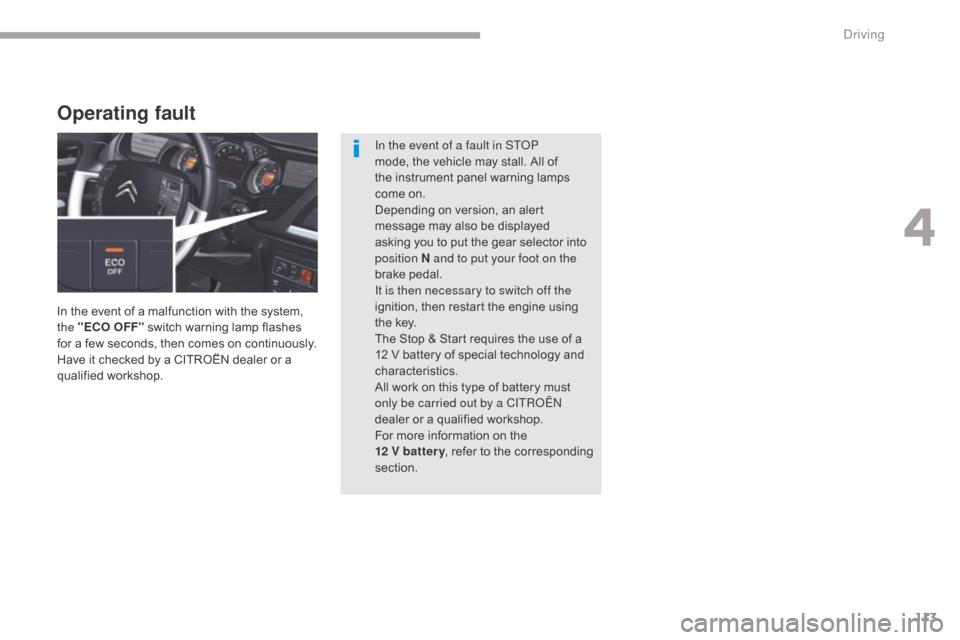
113
C5_en_Chap04_conduite_ed01-2016
Operating fault
In the event of a malfunction with the system,
the "ECO OFF" switch warning lamp flashes
for a few seconds, then comes on continuously.
Have it checked by a CITROËN dealer or a
qualified workshop.In the event of a fault in STOP
mode, the vehicle may stall. All of
the instrument panel warning lamps
come
on.
Depending on version, an alert
message may also be displayed
asking you to put the gear selector into
position
N and to put your foot on the
brake pedal.
It is then necessary to switch off the
ignition, then restart the engine using
the key.
The Stop & Start requires the use of a
12 V battery of special technology and
characteristics.
All work on this type of battery must
only be carried out by a CITROËN
dealer or a qualified workshop.
For more information on the
12
V batter y, refer to the corresponding
section.
4
Driving
Page 121 of 348

119
C5_en_Chap04_conduite_ed01-2016
F Press button 4 to select "LIMIT" speed limiter
mode.
The selection is confirmed by the display of the
" LIMIT " function in zone A of the instrument panel.
Activation
F Press button 3 when the desired maximum
speed is displayed.
The information "ON" then appears in zone A
of the instrument panel.
When the function is selected, the
last memorised speed and the
information
"
PAUS E " are displayed.
With the engine running, you can adjust the
memorised maximum speed, displayed in
zone
A , by pressing:
F
Button 1 to increase the memorised
maximum speed.
F
Button 2 to decrease the memorised
maximum speed.
Successive presses will modify the limit
speed setting in steps of 1 mph (km/h) and a
continuous press in steps of 5 mph (km/h).
Programming
F Press button 3 .
This action causes the information " PAUS E " to
appear in zone A of the instrument panel.
This action does not cancel the memorised
maximum speed which remains displayed in
zone A of the instrument panel.
Pause / Resume
4
Driving
Page 122 of 348
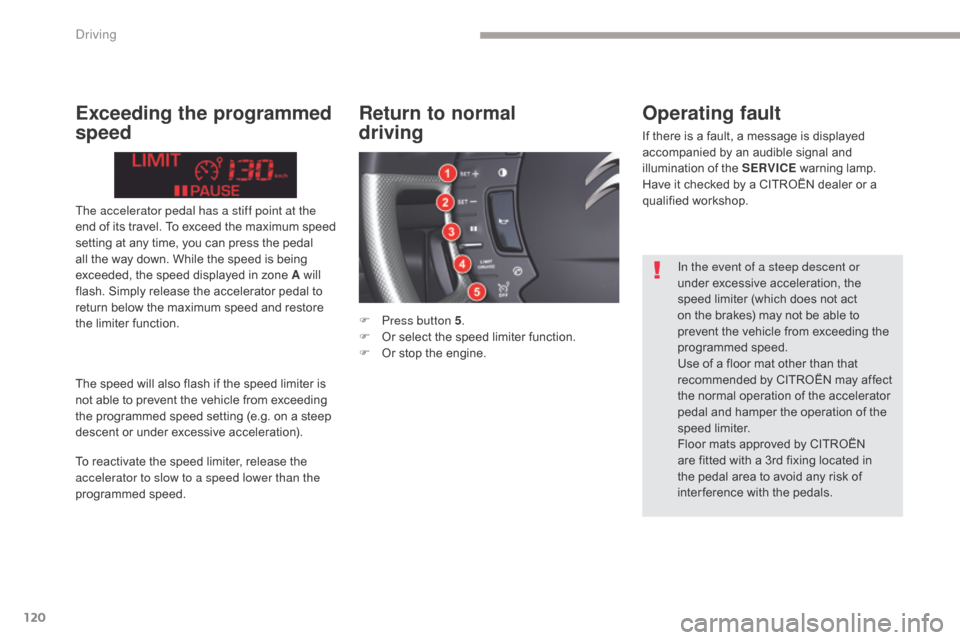
120
C5_en_Chap04_conduite_ed01-2016
The accelerator pedal has a stiff point at the
end of its travel. To exceed the maximum speed
setting at any time, you can press the pedal
all the way down. While the speed is being
exceeded, the speed displayed in zone A will
flash. Simply release the accelerator pedal to
return below the maximum speed and restore
the limiter function.
Return to normal
driving Operating fault
If there is a fault, a message is displayed
accompanied by an audible signal and
illumination of the SERVICE
warning lamp.
Have it checked by a CITROËN dealer or a
qualified workshop.
Exceeding the programmed
speed
In the event of a steep descent or
under excessive acceleration, the
speed limiter (which does not act
on the brakes) may not be able to
prevent the vehicle from exceeding the
programmed speed.
Use of a floor mat other than that
recommended by CITROËN may affect
the normal operation of the accelerator
pedal and hamper the operation of the
speed limiter.
Floor mats approved by CITROËN
are fitted with a 3rd fixing located in
the pedal area to avoid any risk of
inter ference with the pedals.
The speed will also flash if the speed limiter is
not able to prevent the vehicle from exceeding
the programmed speed setting (e.g. on a steep
descent or under excessive acceleration).
To reactivate the speed limiter, release the
accelerator to slow to a speed lower than the
programmed speed. F
P
ress button 5 .
F
O
r select the speed limiter function.
F
O
r stop the engine.
Driving
Page 125 of 348
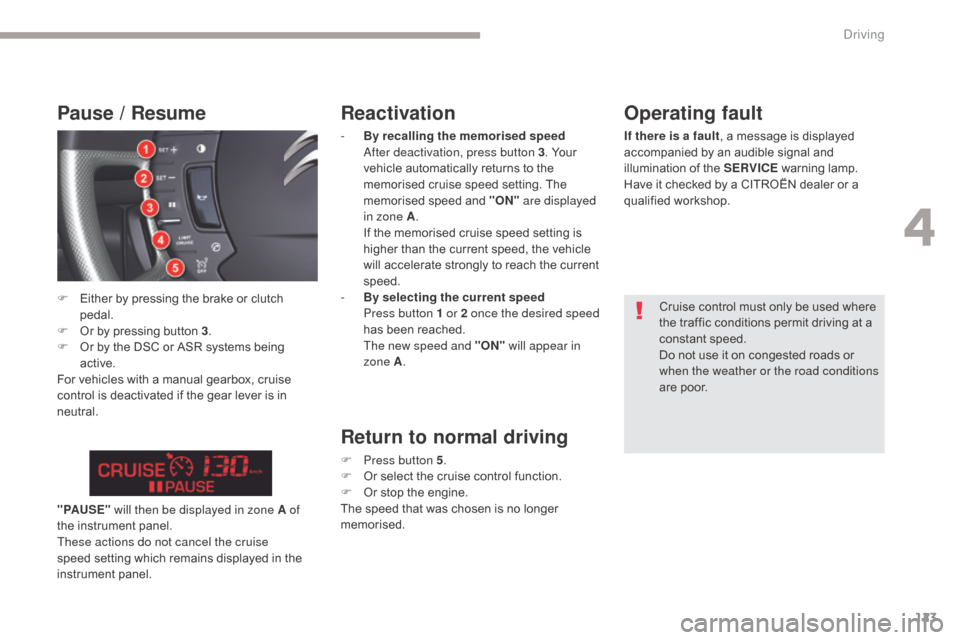
123
C5_en_Chap04_conduite_ed01-2016
Reactivation
- By recalling the memorised speed After deactivation, press button 3. Your
vehicle automatically returns to the
memorised cruise speed setting. The
memorised speed and "ON" are displayed
in zone A .
I
f the memorised cruise speed setting is
higher than the current speed, the vehicle
will accelerate strongly to reach the current
speed.
-
B
y selecting the current speed
P
ress button 1 or 2 once the desired speed
has been reached.
T
he new speed and "ON" will appear in
zone A .
Return to normal driving
F Press button 5 .
F O r select the cruise control function.
F
O
r stop the engine.
The speed that was chosen is no longer
memorised.
" PAUS E "
will then be displayed in zone A of
the instrument panel.
These actions do not cancel the cruise
speed setting which remains displayed in the
instrument panel.
Operating fault
If there is a fault , a message is displayed
accompanied by an audible signal and
illumination of the SERVICE warning lamp.
Have it checked by a CITROËN dealer or a
qualified workshop.
Cruise control must only be used where
the traffic conditions permit driving at a
constant speed.
Do not use it on congested roads or
when the weather or the road conditions
are poor.
Pause / Resume
F Either by pressing the brake or clutch pedal.
F
O
r by pressing button 3 .
F
O
r by the DSC or ASR systems being
active.
For vehicles with a manual gearbox, cruise
control is deactivated if the gear lever is in
neutral.
4
Driving
Page 126 of 348
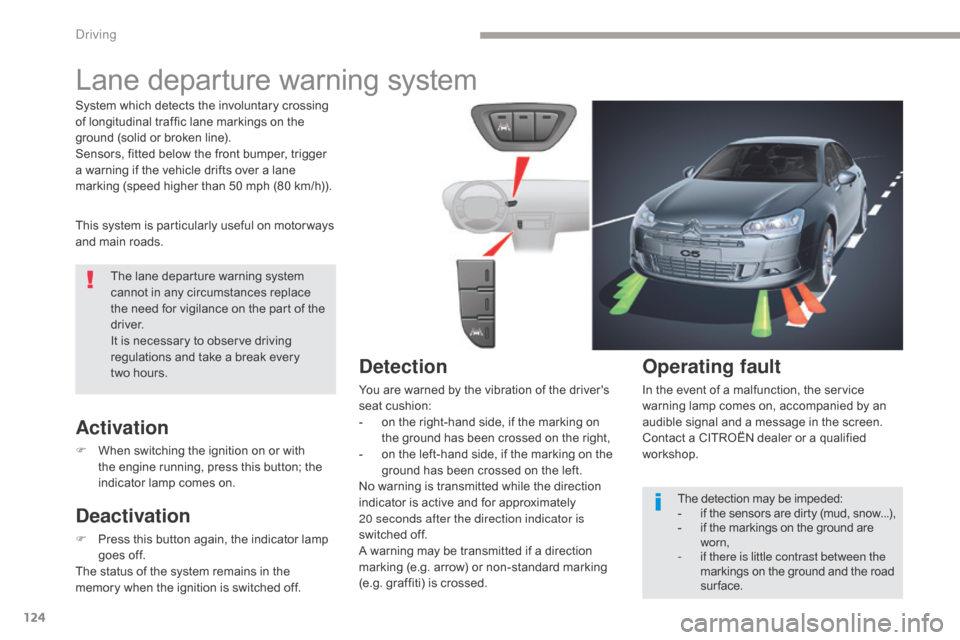
124
C5_en_Chap04_conduite_ed01-2016
Lane departure warning system
This system is particularly useful on motor ways
and main roads.
Activation
F When switching the ignition on or with the engine running, press this button; the
indicator lamp comes on.
Deactivation
F Press this button again, the indicator lamp goes off.
The status of the system remains in the
memory when the ignition is switched off.
Detection
You are warned by the vibration of the driver's
seat cushion:
-
o
n the right-hand side, if the marking on
the ground has been crossed on the right,
-
o
n the left-hand side, if the marking on the
ground has been crossed on the left.
No warning is transmitted while the direction
indicator is active and for approximately
20
seconds after the direction indicator is
switched off.
A warning may be transmitted if a direction
marking (e.g. arrow) or non-standard marking
(e.g. graffiti) is crossed.
Operating fault
In the event of a malfunction, the service
warning lamp comes on, accompanied by an
audible signal and a message in the screen.
Contact a CITROËN dealer or a qualified
workshop.
System which detects the involuntary crossing
of longitudinal traffic lane markings on the
ground (solid or broken line).
Sensors, fitted below the front bumper, trigger
a warning if the vehicle drifts over a lane
marking (speed higher than 50 mph (80 km/h)).
The detection may be impeded:
-
i
f the sensors are dirty (mud, snow...),
-
i
f the markings on the ground are
worn,
-
i
f there is little contrast between the
markings on the ground and the road
sur face.
The lane departure warning system
cannot in any circumstances replace
the need for vigilance on the part of the
driver.
It is necessary to observe driving
regulations and take a break every
two
hours.
Driving
Page 132 of 348
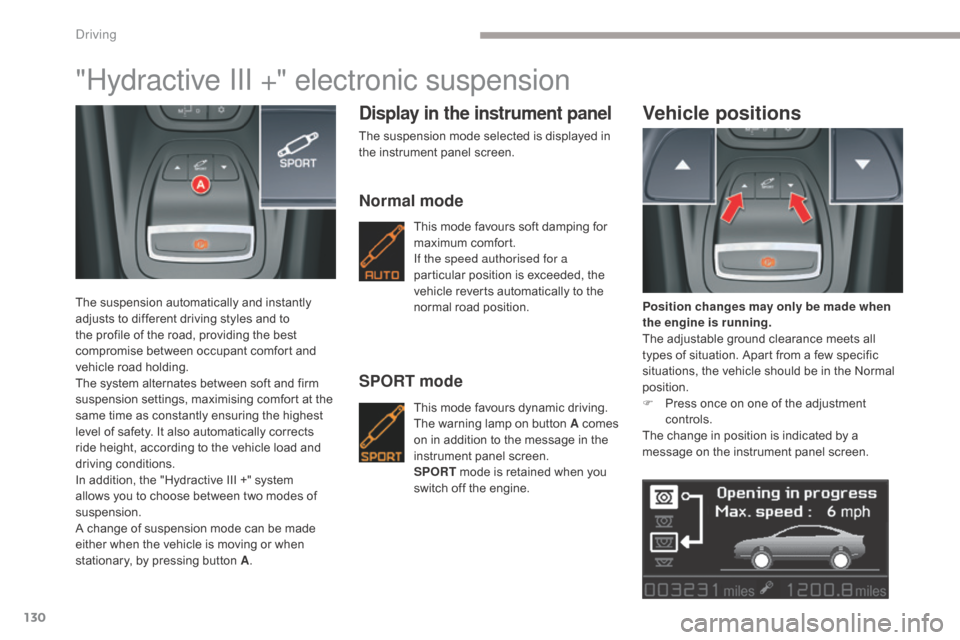
130
C5_en_Chap04_conduite_ed01-2016
"Hydractive III +" electronic suspension
The suspension automatically and instantly
adjusts to different driving styles and to
the profile of the road, providing the best
compromise between occupant comfort and
vehicle road holding.
The system alternates between soft and firm
suspension settings, maximising comfort at the
same time as constantly ensuring the highest
level of safety. It also automatically corrects
ride height, according to the vehicle load and
driving conditions.
In addition, the "Hydractive III +" system
allows you to choose between two modes of
suspension.
A change of suspension mode can be made
either when the vehicle is moving or when
stationary, by pressing button A.
Display in the instrument panel
The suspension mode selected is displayed in
the instrument panel screen.
Normal mode
This mode favours soft damping for
maximum comfort.
If the speed authorised for a
particular position is exceeded, the
vehicle reverts automatically to the
normal road position.
SPORT mode
This mode favours dynamic driving. T
he warning lamp on button A comes
on in addition to the message in the
instrument panel screen.
SPORT mode is retained when you
switch off the engine.
Vehicle positions
Position changes may only be made when
the engine is running.
The adjustable ground clearance meets all
types of situation. Apart from a few specific
situations, the vehicle should be in the Normal
position.
F
P
ress once on one of the adjustment
controls.
The change in position is indicated by a
message on the instrument panel screen.
Driving
Page 135 of 348

133
C5_en_Chap05_eclairage-et-visibilite_ed01-2016
Manual controls
Lighting off (ignition off) /
Daytime running lamps (engine running).
Automatic illumination of headlamps.
Sidelamps.Dipped headlamps or main
beam headlamps.
B.
S
talk for switching headlamps: pull
the stalk towards you to switch the
lighting between dipped and main beam
headlamps.
In the lamps off and sidelamps modes, the
driver can switch on the main beam headlamps
temporarily ("headlamp flash") by maintaining a
pull on the stalk.
Displays
The lighting is controlled directly by the driver
by means of the ring A and the stalk B .A.
M
ain lighting mode selection ring: turn it
to position the symbol required facing the
mark.
C. Foglamps selection ring.
The foglamps operate with the sidelamps and
the dipped and main beam headlamps. Illumination of the corresponding indicator
lamp in the instrument panel confirms that the
lighting selected is on.
5
Lighting and visibility
Page 137 of 348

135
C5_en_Chap05_eclairage-et-visibilite_ed01-2016
Daytime running lampsManual guide-me-home
lighting
Switching on
F With the ignition off, "flash" the headlamps
using the lighting stalk.
F
A f
urther "headlamp flash" switches the
function off.
Switching off
The manual guide-me-home lighting switches
off automatically after a set time.
These special lamps, located at the front, make
the vehicle more visible by day.
The temporary illumination of the dipped beam
headlamps after the vehicle's ignition has been
switched off makes the driver's exit easier
when the light is poor.
They come on automatically and stay on, when
the engine is running and when the lighting
control stalk is at position 0 or AUTO
.
5
Lighting and visibility
Page 150 of 348
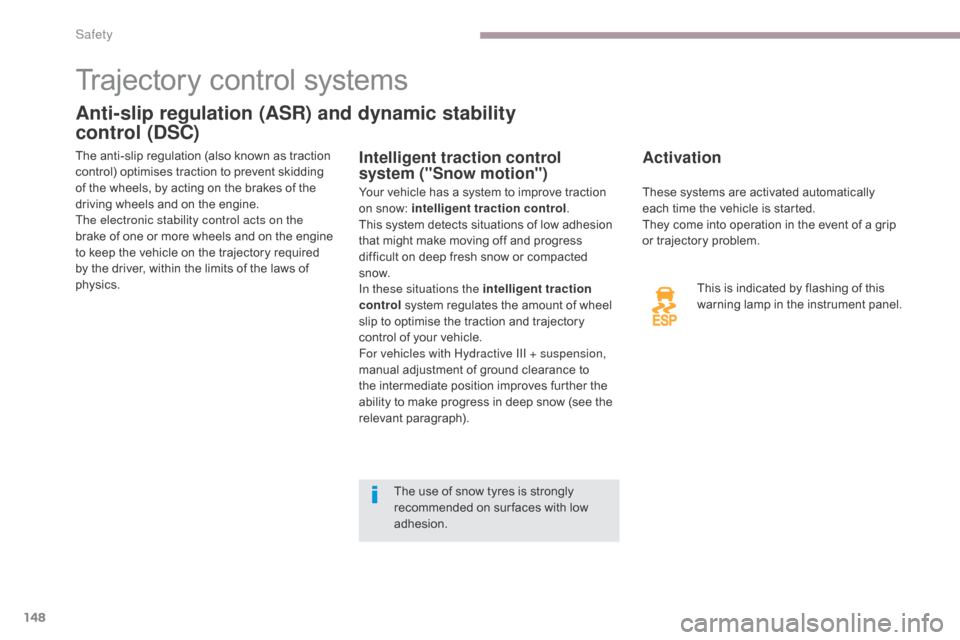
148
C5_en_Chap06_securite_ed01-2016
Trajectory control systems
Anti-slip regulation (ASR) and dynamic stability
control (DSC)
Activation
This is indicated by flashing of this
warning lamp in the instrument panel.
Your vehicle has a system to improve traction
on snow: intelligent traction control
.
This system detects situations of low adhesion
that might make moving off and progress
difficult on deep fresh snow or compacted
snow.
In these situations the intelligent traction
control system regulates the amount of wheel
slip to optimise the traction and trajectory
control of your vehicle.
For vehicles with Hydractive III + suspension,
manual adjustment of ground clearance to
the intermediate position improves further the
ability to make progress in deep snow (see the
relevant paragraph).
The anti-slip regulation (also known as traction
control) optimises traction to prevent skidding
of the wheels, by acting on the brakes of the
driving wheels and on the engine.
The electronic stability control acts on the
brake of one or more wheels and on the engine
to keep the vehicle on the trajectory required
by the driver, within the limits of the laws of
physics.
Intelligent traction control
system ("Snow motion")
These systems are activated automatically
each time the vehicle is started.
They come into operation in the event of a grip
or trajectory problem.
The use of snow tyres is strongly
recommended on sur faces with low
adhesion.
Safety